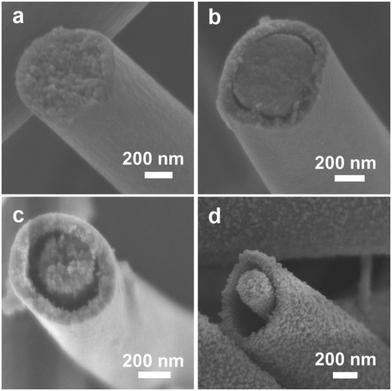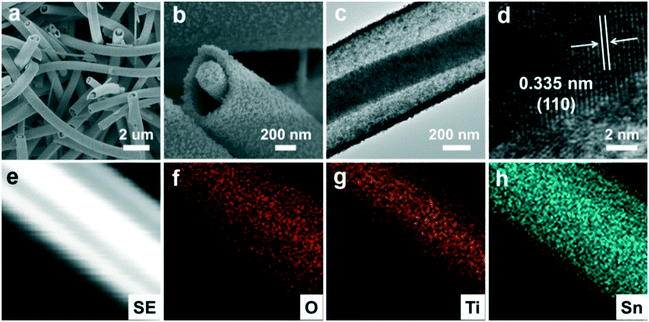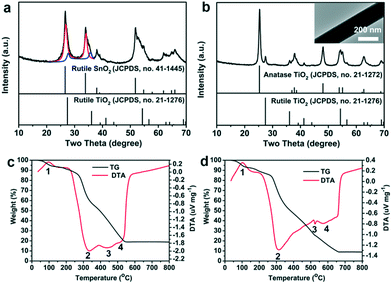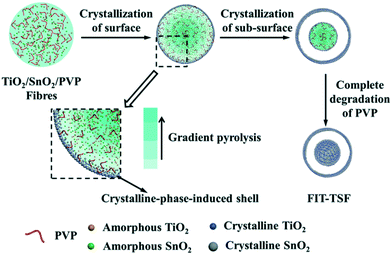Crystalline-phase-induced formation of fibre-in-tube TiO2–SnO2 fibres for a humidity sensor†
Yun
Wang
 ab,
Xiaojuan
Zhao
b,
Zhongmin
Feng
a,
Geyu
Lu
c,
Ting
Sun
*a and
Yan
Xu
ab,
Xiaojuan
Zhao
b,
Zhongmin
Feng
a,
Geyu
Lu
c,
Ting
Sun
*a and
Yan
Xu
 *b
*b
aCollege of Sciences, Northeastern University, Shenyang, Liaoning 110819, China. E-mail: sun1th@163.com
bState Key Lab of Inorganic Synthesis and Preparative Chemistry, Jilin University, Changchun, Jilin 130012, China. E-mail: yanxu@jlu.edu.cn
cState Key Lab on Integrated Optoelectronics, Jilin University, Changchun, Jilin 130012, China
First published on 23rd August 2017
Abstract
Fibre-in-tube TiO2–SnO2 fibres (FIT-TSF) have been successfully fabricated via a general crystalline-phase-induced formation strategy. The as-prepared FIT-TSF exhibited excellent sensing properties with an impedance change of three orders of magnitude, an ultrafast response time of 5 s, a recovery time of 8 s, and good reproducibility.
One-dimensional (1D) semiconductor materials with varying levels of interior cavities, including hollow, fibre-in-tube, tube-in-tube, multi-core cable-like, etc., have demonstrated many structure merits such as efficient mass and electron transport, which could endow them with functional activity in catalysis, biomedical devices, energy harvesting and storage, and biological and chemical sensors.1–7 Enrichment of 1D functional materials with similar structures and further understanding of the controllability on structures are still highly desirable nowadays.
Transforming solid electrospun fibres into the above-mentioned structures by controlled calcination has been proved to be an effective way to construct a variety of 1D functional materials, such as TiO2,3,4 SnO2,5–7 CuO,8 Fe2O3,9 CdS/ZnO,10 TiO2–VxOy,11 ZnFe2O4 (ref. 12) and BiFeO3.13 Based on those studies, we can summarize that the hollowing evolution process of the solid electrospun fibres can be characterized as follows: 1) at the low-temperature stage (300–400 °C), polymers, like polyvinylpyrrolidone (PVP), pyrolyze first at the oxygen-rich fibre surface; meanwhile, the inorganic species begin to undergo phase transformation to form crystalline shells. 2) At the high-temperature stage (>400 °C), the residual polymer is melted and pyrolyzed, and the inorganic species continue to undergo crystallization with various migration events depending on the mechanisms of Oswald ripening, oriented attachment, or the Kirkendall effect, leading to different interior structures.3–13 The above process is likely to be highly sensitive to the divergence of the crystalline shells and the continuously-consumed inner part. The greater the divergence, the easier the evolution of the interior cavities. Studies show that by doping metal elements or mixing metal oxides the phase transformation temperature of the electrospun fibres may be reduced and the pyrolysis of the polymers may be facilitated, thus enhancing the divergence.11 So, such a crystalline-phase-induced evolution is expected to be effective for the fabrication of more 1D functional materials with controllable interior cavities.
Herein, we demonstrate a general crystalline-phase-induced formation strategy for the fabrication of fibre-in-tube TiO2–SnO2 fibres (FIT-TSF) to verify the above speculations. Compared with pure TiO2 fibres, rutile-phase SnO2 tends to induce the phase transformation of the shells to prevent further contraction of the outer shells, and catalyze the pyrolysis of the inner polymers, leading to the formation of fibre-in-tube structures. The as-prepared FIT-TSF exhibited excellent sensing properties with ultrafast response and good reproducibility.
The morphology and composition of the as-prepared FIT-TSF were characterized using FESEM, TEM and XRD. As shown in Fig. 1a, well-defined FIT-TSF is depicted on a large scale. The diameters of the shell and the inner fibre are about 750 and 280 nm, respectively. The cross-sectional view in Fig. 1b and the corresponding TEM image in Fig. 1c further demonstrate the fibre-in-tube nature of the product. Both the shell and the inner fibre are composed of nanoparticles. The lattice separation of 0.335 nm in the HRTEM image (Fig. 1d) corresponds to the (110) plane of rutile SnO2 or rutile TiO2.13,14 The HAADF-STEM image and the corresponding EDX elemental mapping images in Fig. 1e–h indicate that both Sn and Ti elements are uniformly distributed in the FIT-TSF network. X-ray photoelectron spectroscopy (XPS) was also carried out to analyse the chemical compositions of the FIT-TSF. As shown in Fig. S1,† binding energies at 458.7 and 464.5 eV assignable to 2p3/2 and 2p1/2 of Ti4+ in TiO2 are observed for the FIT-TSF.15 Meanwhile, the Sn 3d spectrum exhibits two main peaks at 486.3 and 494.7 eV, corresponding to Sn 3d5/2 and Sn 3d3/2, respectively, further confirming the co-existence of Sn4+.16 Furthermore, the O 1s peak of the FIT-TSF can be deconvoluted to two peaks at 529.9 eV and 531.5 eV, where the binding energy at 529.9 eV may be ascribable to the crystal lattice oxygen (Ti–O–Sn) and the binding energy at 532.8 eV may be attributed to the surface hydroxyl groups (Ti–OH).17 Both of the heterojunctions of TiO2 and SnO2 and the surface hydroxyl groups may possess advantages of superior water adsorption–desorption behaviour, and thus enhanced humidity sensing abilities.15,17–19
The XRD pattern in Fig. 2a depicts that the FIT-TSF are a mixed-phase of rutile SnO2 and rutile TiO2. The deconvoluted peaks at 26.6° and 33.9° can be readily indexed to rutile SnO2 crystal planes (110) and (101) (JCPDS, no. 41-1445), while the peaks located at 27.6° and 36.0° can be indexed to the (110) and (101) crystal planes of rutile TiO2 (JCPDS, no. 21-1276). A comparative experiment without SIPO was conducted using the same process. The resultant TiO2 fibres are solid ones, and mainly in the anatase phase (Fig. 2b and inset). The result confirms that rutile-phase SnO2 can significantly reduce the phase transformation temperature because of the low lattice mismatch between the rutile-phase SnO2 and rutile TiO2 structures, which also tends to induce the locking-up of the crystalline shells.
Fig. 2c and d are the TG-DTA curves of the as-electrospun PVP/TiO2/SnO2 and PVP/TiO2 composite fibres. Both of the samples show typical three distinct weight loss stages from room temperature to 800 °C, in which there exist one endothermic peak and three exothermic peaks in the DTA curves. As shown in Fig. 2c, the endothermic peak at about 98 °C (peak 1) indicates the evaporation of adsorbed water and other solvents. The exothermic peaks at 334 °C (peak 2) and 441 °C (peak 3) correspond to the degradation of PVP by dehydration in the polymer side chain and the crystallization of surface amorphous inorganics. The exothermic peak at 517 °C (peak 4) indicates complete decomposition of the residual PVP and the phase transformation of the inorganics. It is noteworthy that the temperatures of peak 3 and peak 4 shift to higher temperatures in the DTA curve in Fig. 2d, and the eventual weight loss temperature shifts to 661 °C. These results further confirm that the rutile-SnO2 can accelerate the phase transformation and catalyze PVP pyrolysis, leading to the enhancement of the divergence between the outer and inner layers of the fibre-in-tube structures.
In order to gain insight into the formation process of the FIT-TSF, the structural evolution of the fibres calcined at different temperatures was investigated. The as-electrospun PVP/TiO2/SnO2 composite fibres are uniform solids with a diameter of about 1.6 μm. No phase separation is found from the SEM and TEM images in Fig. S2.†20 Then, the composite fibres were calcined at increasing temperature. The XRD patterns in Fig. S3† show that the fibres crystallize and grow with increasing temperature. A small diffraction peak can be found after calcination at 400 °C, indicating the crystallization of surface amorphous inorganics. Although the fibres are still solid (Fig. 3a), the increasing surface crystallization may facilitate the locking-up of the outer shell of the fibres. With the increase in temperature to 500 °C, a clear small gap emerges between the outer shell and the inner fibres, forming a fibre-in-tube structure of a crystalline shell and an amorphous inner part (Fig. 3b). When the calcination duration was further prolonged to 3 h, the diffraction peaks become sharper, and the residual PVP continues to undergo pyrolysis, leading to the enhancement of the divergence between the outer and inner layers (Fig. 3c). Finally, well-defined FIT-TSF are formed after 6 h of calcination at 500 °C (Fig. 3d). Besides, less SnO2 would reduce the divergence between the outer and inner layers. For example, we reduced the SIPO contents of the electrospinning solution from the TBT/SIPO molar ratio of 1.0 to 3.0, and the resultant fibre-in-tube structure shows a thickened shell and narrow divergence (Fig. S4†).
 | ||
| Fig. 3 High magnification SEM showing the structural evolution of the FIT-TSF calcined at different temperatures: (a) 400 °C for 0 h, (b) 500 °C for 0 h, (c) 500 °C for 3 h, and (d) 500 °C for 6 h. | ||
Based on the current work and reported literature, a crystalline-phase-induced formation process has been proposed to account for the fibre-in-tube structure. As illustrated in Fig. 4, calcination at low temperatures (300–400 °C) will cause a rapid degradation of surface PVP, as well as the crystallization of surface amorphous inorganics. Rutile-phase SnO2 can facilitate the phase transformation of surface TiO2, inducing the rapid lock-up of crystalline shells. The gradient pyrolysis of PVP from the surface to the core will cause the shrinking of the amorphous inner part. The faster the pyrolysis, the greater the divergence between the crystalline shell and the amorphous inner part. Then, the sub-surface of the amorphous part will crystallize and the residual PVP continues to undergo pyrolysis till the crystalline fibre-in-tube structure is formed.
The humidity sensing characteristics of the FIT-TSF are shown in Fig. 5. The as-prepared sensor exhibits an impedance change of three orders of magnitude in the whole humidity range from 11% to 98% RH. It also shows rapid response and recovery characteristics at 10 Hz at room temperature. The response time (T90) and recovery time (T′90) are about 5 s and 8 s, respectively. Such an ultrafast response and recovery behaviour could be explained by the fibre-in-tube structures of the as-prepared TiO2–SnO2 fibres, which can provide enhanced mass transport of the water molecules and efficient electron transport along the fibrous axis. Besides, the low lattice mismatch between SnO2 and TiO2 would lead to a suitable heterojunction and an efficient interfacial electron transfer, which thus promotes the water adsorption behaviour.17 The surface hydroxyl groups would also enhance the hydrophilic characteristic of the FIT-TSF. So, the concerted effect of fibre-in-tube structures, SnO2/TiO2 heterojunctions and surface hydroxyl groups is proposed to account for the enhanced humidity sensing abilities. Moreover, the sensor shows good reproducibility; there are few changes in impedances after 10 cycles (Fig. 5c). Compared with other reported TiO2 and SnO2 based humidity sensors, the current FIT-TSF sensor exhibits higher humidity sensing characteristics than most of the selected sensors (Table S1†). These excellent sensing characteristics might facilitate the application of FIT-TSF to high-performance humidity nano-detectors.
In summary, TiO2–SnO2 fibres with fibre-in-tube structures have been facilely fabricated by a typical electrospinning procedure and subsequent calcination. Based on the current work and reported studies, a crystalline-phase-induced formation process has been proposed to account for the fibre-in-tube structure. Moreover, the as-prepared FIT-TSF exhibited excellent sensing characteristics. The current crystalline-phase-induced strategy may guide the fabrication of more fibre-in-tube functional materials.
This work was supported by the Start-up Fund of Northeastern University (02060022117021), the National Natural Science Foundation of China (21171067, 21373100), and the State Key Laboratory of Advanced Technology for Materials Synthesis and Processing, Wuhan University of Technology (30347080401).
Conflicts of interest
There are no conflicts to declare.Notes and references
- J. Wu, N. Wang, Y. Zhao and L. Jiang, J. Mater. Chem. A, 2013, 1, 7290–7305 CAS
.
- C. Niu, J. Meng, X. Wang, C. Han, M. Yan, K. Zhao, X. Xu, W. Ren, Y. Zhao, L. Xu, Q. Zhang, D. Zhao and L. Mai, Nat. Commun., 2015, 6, 7402 CrossRef PubMed
.
- L. Lang, D. Wu and Z. Xu, Chem. – Eur. J., 2012, 18, 10661–10668 CrossRef CAS PubMed
.
- J. S. Cho, Y. J. Hong and Y. C. Kang, Chem. – Eur. J., 2015, 21, 11082–11087 CrossRef CAS PubMed
.
- J. Wu, D. Zeng, X. Wang, L. Zeng, Q. Huang, G. Tang and C. Xie, Langmuir, 2014, 30, 11183–11189 CrossRef CAS PubMed
.
- Y. J. Hong, J.-W. Yoon, J.-H. Lee and Y. C. Kang, Chem. – Eur. J., 2015, 21, 371–376 CrossRef CAS PubMed
.
- B. R. Koo, S. T. Oh and H. J. Ahn, Mater. Lett., 2016, 178, 288–291 CrossRef CAS
.
- H. Xiang, Y. Long, X. Yu, X. Zhang, N. Zhao and J. Xu, CrystEngComm, 2011, 13, 4856–4860 RSC
.
- F. Mou, J.-g. Guan, W. Shi, Z. Sun and S. Wang, Langmuir, 2010, 26, 15580–15585 CrossRef CAS PubMed
.
- G. Yang, W. Yan, Q. Zhang, S. Shen and S. Ding, Nanoscale, 2013, 5, 12432–12439 RSC
.
- X. Zhao, Y. Wang, H. Chen and Y. Xu, CrystEngComm, 2016, 18, 8637–8644 RSC
.
- J. Yan, S. Gao, C. Wang, B. Chai, J. Li, G. Song and S. Chen, Mater. Lett., 2016, 184, 43–46 CrossRef CAS
.
- L. Shi and H. Lin, Langmuir, 2011, 27, 3977–3981 CrossRef CAS PubMed
.
- Y. Wang, H. Huang, G. Li, X. Zhao, L. Yu, C. Zou and Y. Xu, CrystEngComm, 2017, 19, 2673–2680 RSC
.
- M. Zhang, C. Shao, Z. Guo, Z. Zhang, J. Mu, T. Cao and Y. Liu, ACS Appl. Mater. Interfaces, 2011, 3, 369–377 CAS
.
- X. Sun, Y. Huang, M. Zong, H. Wu and X. Ding, J. Mater. Sci.: Mater. Electron., 2016, 27, 2682–2686 CrossRef CAS
.
- Z. Yang, Z. Zhang, K. Liu, Q. Yuan and B. Dong, J. Mater. Chem. C, 2015, 3, 6701–6708 RSC
.
- Z. Zhang, J. Huang, Q. Yuan and B. Dong, Nanoscale, 2014, 6, 9250–9256 RSC
.
- Z. Zhang, J. Huang, B. Dong, Q. Yuan, Y. He and O. S. Wolfbeis, Nanoscale, 2015, 7, 4149–4155 RSC
.
- Z. Zhang, X. Li, C. Wang, L. Wei, Y. Liu and C. Shao, J. Phys. Chem. C, 2009, 113, 19397–19403 CAS
.
Footnote |
| † Electronic supplementary information (ESI) available: Details of the experimental section. See DOI: 10.1039/c7ce01106g |
| This journal is © The Royal Society of Chemistry 2017 |




